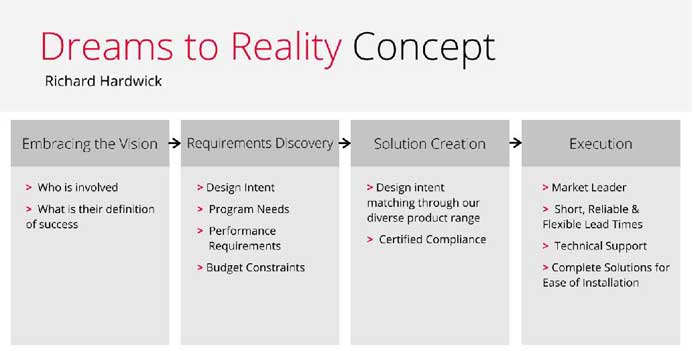Architecture exists to design and create harmonious physical environments for people to work and live in. We understand that great architecture is not only appealing to look at, but also can benefit how we act and collaborate within the space. Benefits of great architecture in schools extend even further, including increased student engagement, more potential for collaboration, boost in community support, and often a higher return on investment for the education firm.
Supawood’s Dreams to Reality process allows architects to achieve these benefits in schools, offering technical, acoustic and product support, to help transform an architect’s project dreams into a reality.
Importance of good acoustics in education spaces:
Michael Phillips, an acoustic engineer at Michael Phillips Acoustics, outlines in the webinar some typical acoustic considerations for education spaces:
- External noise intrusions – including traffic & aircraft. Design of façade and glazing is considered to minimise this impact.
- Building services noise intrusions – including plumbing and air-con noise. Correct standards are observed to ensure the correct noise level of a space is reached in the space, and these intrusions are minimised. Preparing early and working with the architects and manufacturers are vital for acoustic engineers to ensure the end result is to the correct standard followed for education spaces.
- Noise transfer between spaces – such as between classrooms, sports areas, and music areas.
- Reverberation & Echoes. This is the most common acoustical consideration, as we need to ensure each room has appropriate reverberation control.
Each of these considerations is vital, especially from the early stages of the project design and planning. This ensures there are no nasty surprises in the completed space.
Importance of good architecture in education spaces:
As Professor Paul Sanders discusses in the webinar, the focus on design for health and wellbeing has been particularly prevalent in recent years. This specifically focuses on aspects of interiority, such as how the environments are designed, sensory design such as light, sound and acoustics, and environmental quality. This links directly to the benefit of increased student engagement with good architecture in schools. Through a positively designed school space, often tailored exactly to the needs of the particular school model, students are able to engage and collaborate with each other much easier. As we know, humans are products of their environment.
How can the Supawood Dreams to Reality concept help you and your project?
From the start, Supawood have been focused on bringing value to the architect and are constantly seeking to understand exactly ‘what they want’. We have formulated a concept that we refer to as the ‘Dreams to Reality’ concept. This is often applied in school projects because, as discussed, a ‘dream’ school environment is different for each school model, and different design elements suit different firms and how they wish the students to move and feel within a space.
First off in the Dreams to Reality process, we go through a process of discovery, and seek to understand exactly what the architect is trying to achieve with their design intent. This includes not only addressing the needs of the architect, but also the builder.
For example, with the Knox Grammar project, Supawood discovered the builders’ concern with the framing behind the reflective wall panels in the performing arts centre. Once we had established this pain point, we eliminated this by including the framing as a part of the panel supply.
As Richard Hardwick touched on in our webinar, Supawood understands that there is no point in having a design intent, unless you can build it.
Furthermore, there is no sense in having buildability of the design, unless it complies with the various fire, acoustic and sustainability compliance requirements of the project.
The full Dreams to Reality solution provided by Supawood is outlined below in a complete, easy-to-understand concept. We are ready to chat with you and go over your own project requirements based off this simple model of execution below.

To learn more about our Dreams to Reality concept and hear from Damien Jones about his experience with the Dreams to Reality process on the Knox Grammar project, view the page here.
To read the full Knox Grammar project story, click here.
In conclusion, a number of key factors are looked at and considered in the positive architecture of an education space. In order to optimise student engagement, collaboration, and even health and wellbeing of the students and staff using the space, a number of factors must be considered. These, of course, include the physical appearance and design of the space, but also the acoustics and unseen factors that help achieve success in these projects. Once design is looked after, Supawood will complete their Dreams to Reality service, giving architects and builders alike the peace of mind that their Dream education project is buildable and can be turned into a reality.
Download the whitepaper to find out more here.
For any enquiries, contact us here.

